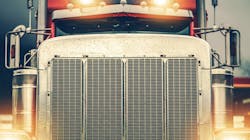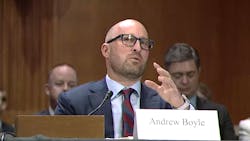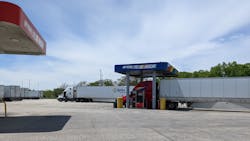Cutting taxes could cut emissions faster than imposing EVs on fleets
The quickest way to cut trucking emissions would be to make it easier for fleets and independent drivers to purchase modern diesel equipment instead of pushing electric car technology onto the freight industry.
Andrew Boyle, first vice chairman of the American Trucking Associations, brought this solution to Congress on April 18. He was testifying before a Senate subcommittee about the more stringent emissions regulations proposed by the U.S. Environmental Protection Agency last week.
“The line of demarcation that most people refer to with diesel technology emissions was 2010,” Boyle, who is also co-president of Boyle Transportation, told a Senate subcommittee on April 18. “Right now, if we look at the national fleet of Class 8 trucks, 47% of them are still pre-2010.”
Two new sets of rules by the EPA are pushing fleets and consumers to adopt zero-emission vehicles The EPA's Phase 3 Greenhouse Gas standards for heavy equipment and multipollutant standards for light- and medium-duty vehicles are the final two parts of the Biden administration's three-step Clean Trucks Plan, first announced in 2021. The heavy-duty standards go beyond the Phase 2 GHG standards finalized in 2016 for model year 2027 trucks.
See also: Fleets in the 'messy middle' can chew gum and walk at the same time
With enough charging infrastructure to power newer zero-emissions heavy-duty trucks years from reality, Boyle told the Senate's Environmental and Public Works' climate subcommittee that Congress could help by removing obstacles to buying more efficient diesel trucks.
Century-old tax holds back trucking
Modern heavy-duty diesel equipment produces nearly 99% less emissions than large trucks built in 1988, according to ATA. He also pointed out to the committee that a tractor-trailer can refuel in about 15 minutes with enough diesel to travel 1,200 miles. While current Class 8 EVs can take many hours to recharge and typically have ranges shorter than 300 miles.
But fleets and owner-operators also run older equipment because the upfront costs of more efficient trucks can be a hurdle.
"A huge impediment to buying newer, cleaner trucks—even today's trucks—is the Federal Excise Tax that was installed more than 100 years ago to finance World War I," Boyle said. "So a big issue, when we look at the emissions in aggregate right now, is not so much that today's trucks aren't clean enough. It's just that of the fleet on the road—not enough are today's trucks. This is one level we have to make it more affordable for fleets and operators to buy today's trucks."
See also: Can EV enthusiasm spark FET repeal?
Enacted as a 3% tax on truck purchases in 1917, the FET now adds 12% to the cost of heavy-duty tractors, trucks, and trailers. With a battery-electric Class 8 truck costing about $300,000 more than its diesel counterpart, Boyle said that government incentives would barely cover the FET upcharge.
Previous bipartisan attempts to repeal the tax have failed. But ATA, along with the American Truck Dealers and Zero Emission Transportation Association, recently called on Congress to repeal FET in the interest of decarbonization and safety.
"Over 90% of the nation's trucking fleets operate six or fewer trucks, and the regressive nature of the FET makes it disproportionately hard for these small businesses, many of which are family-owned and operated, to purchase new equipment," a joint letter sent to Congress in February from the three trade organizations said. "Larger fleet operators take longer to modernize their vehicles due to price increases from the onerous excise tax."
Finding a 'logical' path to zero
Senator Edward Markey (D-Massachusetts), the subcommittee chairman, noted that transportation emissions account for more than a quarter of total greenhouse gas emissions in the U.S.
"More than half of which come from light-duty vehicles and a quarter of which comes from heavy-duty vehicles and trucks," he said. "Cars and trucks also produce nitrogen oxides and other toxic pollution that increases asthma and cancer rates, harming public health and disproportionately affecting Black, Brown and indigenous communities."
Markey cited EPA projections that show its heavy-duty proposal creating up to $320 billion in net benefits for the U.S. economy while avoiding 1.8 billion tons of CO2 through 2055.
See also: The emissions race: Does trucking's future still have ICE in its veins?
"We share your concern in your drive toward zero emissions," Boyle said. "The trucking industry starts at yes. We are on that path. And we share the concern about all different communities, rural and urban. But the path to get there has to be logical."
He noted that California, which is pushing even more stringent emissions regulations than the federal government, has some of the oldest fleet equipment in the U.S. "Fifty-two percent of California trucks are pre-2010 diesel emissions," Boyle said. "If we got them current to today, there would be an 83% reduction with the existing infrastructure. So it's not that we do not want to reduce emissions. We're fully on board with that."
He noted that EV market opportunities for consumers differ from the freight market. While millions of passenger cars are purchased in the U.S. each year, the trucking industry is closer to "a couple hundred thousand."
Senator Pete Ricketts (R-Nebraska), the subcommittee's ranking member, followed up on a Boyle comment that it would cost a "trillion dollars" to convert the U.S. trucking industry to zero emission. "The American consumer will end up paying that," Ricketts said.
About the Author
Josh Fisher
Editor-in-Chief
Editor-in-Chief Josh Fisher has been with FleetOwner since 2017. He covers everything from modern fleet management to operational efficiency, artificial intelligence, autonomous trucking, alternative fuels and powertrains, regulations, and emerging transportation technology. Based in Maryland, he writes the Lane Shift Ahead column about the changing North American transportation landscape.



